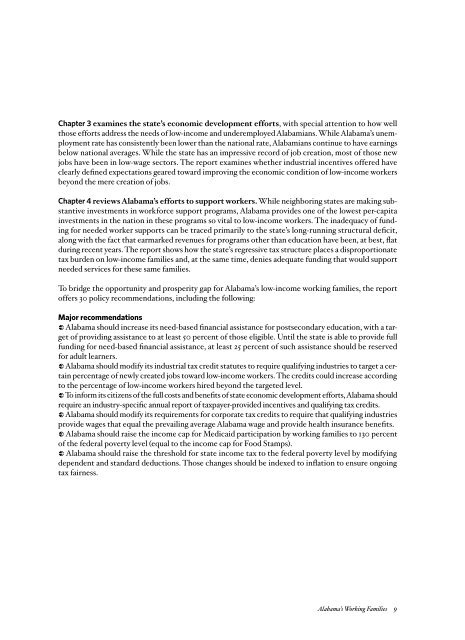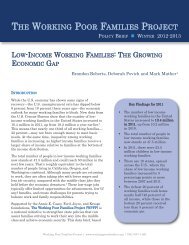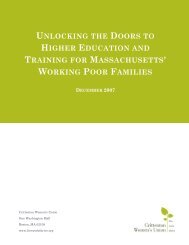alabama's working families and the broken promise of economic ...
alabama's working families and the broken promise of economic ...
alabama's working families and the broken promise of economic ...
- No tags were found...
Create successful ePaper yourself
Turn your PDF publications into a flip-book with our unique Google optimized e-Paper software.
Chapter 3 examines <strong>the</strong> state’s <strong>economic</strong> development efforts, with special attention to how wellthose efforts address <strong>the</strong> needs <strong>of</strong> low-income <strong>and</strong> underemployed Alabamians. While Alabama’s unemploymentrate has consistently been lower than <strong>the</strong> national rate, Alabamians continue to have earningsbelow national averages. While <strong>the</strong> state has an impressive record <strong>of</strong> job creation, most <strong>of</strong> those newjobs have been in low-wage sectors. The report examines whe<strong>the</strong>r industrial incentives <strong>of</strong>fered haveclearly defined expectations geared toward improving <strong>the</strong> <strong>economic</strong> condition <strong>of</strong> low-income workersbeyond <strong>the</strong> mere creation <strong>of</strong> jobs.Chapter 4 reviews Alabama’s efforts to support workers. While neighboring states are making substantiveinvestments in workforce support programs, Alabama provides one <strong>of</strong> <strong>the</strong> lowest per-capitainvestments in <strong>the</strong> nation in <strong>the</strong>se programs so vital to low-income workers. The inadequacy <strong>of</strong> fundingfor needed worker supports can be traced primarily to <strong>the</strong> state’s long-running structural deficit,along with <strong>the</strong> fact that earmarked revenues for programs o<strong>the</strong>r than education have been, at best, flatduring recent years. The report shows how <strong>the</strong> state’s regressive tax structure places a disproportionatetax burden on low-income <strong>families</strong> <strong>and</strong>, at <strong>the</strong> same time, denies adequate funding that would supportneeded services for <strong>the</strong>se same <strong>families</strong>.To bridge <strong>the</strong> opportunity <strong>and</strong> prosperity gap for Alabama’s low-income <strong>working</strong> <strong>families</strong>, <strong>the</strong> report<strong>of</strong>fers 30 policy recommendations, including <strong>the</strong> following:Major recommendations[ Alabama should increase its need-based financial assistance for postsecondary education, with a target<strong>of</strong> providing assistance to at least 50 percent <strong>of</strong> those eligible. Until <strong>the</strong> state is able to provide fullfunding for need-based financial assistance, at least 25 percent <strong>of</strong> such assistance should be reservedfor adult learners.[ Alabama should modify its industrial tax credit statutes to require qualifying industries to target a certainpercentage <strong>of</strong> newly created jobs toward low-income workers. The credits could increase accordingto <strong>the</strong> percentage <strong>of</strong> low-income workers hired beyond <strong>the</strong> targeted level.[ To inform its citizens <strong>of</strong> <strong>the</strong> full costs <strong>and</strong> benefits <strong>of</strong> state <strong>economic</strong> development efforts, Alabama shouldrequire an industry-specific annual report <strong>of</strong> taxpayer-provided incentives <strong>and</strong> qualifying tax credits.[ Alabama should modify its requirements for corporate tax credits to require that qualifying industriesprovide wages that equal <strong>the</strong> prevailing average Alabama wage <strong>and</strong> provide health insurance benefits.[ Alabama should raise <strong>the</strong> income cap for Medicaid participation by <strong>working</strong> <strong>families</strong> to 130 percent<strong>of</strong> <strong>the</strong> federal poverty level (equal to <strong>the</strong> income cap for Food Stamps).[ Alabama should raise <strong>the</strong> threshold for state income tax to <strong>the</strong> federal poverty level by modifyingdependent <strong>and</strong> st<strong>and</strong>ard deductions. Those changes should be indexed to inflation to ensure ongoingtax fairness.Alabama’s Working Families 9







